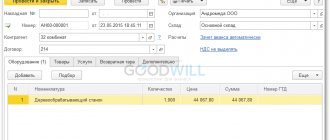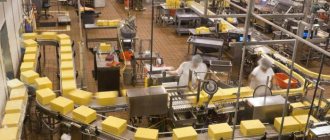Fixed assets, otherwise called fixed assets , capital, property assets, etc., are part of the national welfare. That which takes part in the production process for quite a long period, without essentially changing, but only wearing out and losing value, gradually transfers its value to the products produced.
The lion's share of the national property of our state is concentrated in the form of fixed assets. They are very diverse, so it is necessary to understand their composition, know which groups a particular asset can be classified into, and also according to what principle they can be distributed.
We consider all issues related to the classification of an enterprise’s assets – its fixed assets.
On what basis can fixed assets be classified?
To analyze the composition of the operating system, various grouping bases are used. Everything a business owns can be viewed in different contexts:
- industry of application – means for the production of goods, provision of services or performance of work;
- property – property assets can be divided according to their forms of ownership into public, private, etc.;
- involvement - according to the degree of involvement in the activities of the enterprise, one can distinguish directly used operating systems, backup, spare, repaired, reconstructed, mothballed, etc.;
- source – own property, rented, leased, etc.;
- territory - fixed assets on the balance sheet of a particular enterprise, industry, district, republic, territory, region, city or any other structural territorial unit;
- age – a certain depreciation group, that is, division depending on the maximum useful life;
- form of existence – tangible and intangible funds (according to the all-Russian classifier).
Let's look at the most common grounds for classifying fixed assets.
Classification
To study the composition of fixed assets, groupings are used according to the following criteria:
- by economic sectors - fixed assets of industries producing goods and providing services;
- by type of ownership - fixed assets owned by state, private and other types of property;
- according to the system of participation in the production process - fixed assets directly used in the process of production of products (works, services), and inactive fixed assets, including those in reserve, under conservation, under repair, under reconstruction;
- by ownership - own and leased fixed assets;
- on a territorial basis - fixed assets of districts, republics, territories, regions and cities.
Sources of data on fixed assets:
- regular statistical reporting on the availability and movement of fixed assets
- one-time statistical reporting on revaluation of fixed assets
- business register data and sample survey data.
Based on ownership, fixed assets are divided into owned and leased. Basic production assets, depending on the degree of their impact on the subject of labor, are divided into active and passive.
Tangible and intangible
According to the all-Russian classifier, fixed assets are divided into tangible and intangible .
- Buildings (except housing).
- Facilities.
- Dwellings.
- Cars and equipment.
- Vehicles.
- Tools, production and household equipment.
- Working and productive livestock.
- Perennial plantings.
- Other fixed assets.
Buildings - buildings and structures in which the processes of main, auxiliary and auxiliary production take place; administrative buildings; economic buildings. In addition to the construction part, the cost of these objects also includes the cost of heating systems, plumbing, electrical fittings, ventilation devices, etc. The cost of buildings as part of the main industrial and production assets of Russia accounts for 28%.
Facilities . The group of structures, corresponding to 21%, includes engineering and construction facilities that are necessary for the production process: roads, overpasses, tunnels, bridges, etc.
Machinery and equipment - power machines and equipment, including all types of power units and engines; working machines and equipment that directly affect the subject of labor or its movement in the process of creating products; measuring or regulating instruments and devices and laboratory equipment intended for measurements, regulation of production processes, testing and research; Since 1972, computer technology has been separated into a separate subgroup: electronic computing, analog control machines, as well as machines and devices used to control production and technological processes; other machines and equipment that are not included in the listed subgroups.
The share of the “machinery and equipment” group in 2002 was 43% in the total value of industrial fixed assets.
Vehicles (rolling stock of railways, water and road transport owned by enterprises, as well as in-plant vehicles: trucks, trolleys, trolleys, etc.). The share of vehicles increased to 18%.
Funds depending on their purpose
According to the function that property funds perform, they can be divided into two large independent groups:
- production assets: those that are used and/or created in the process of the enterprise’s activities;
- non-productive assets : those that help serve production without directly affecting the quantity of product produced.
Funds related to production are reproduced through additional capital investments, just like non-production ones. The main difference between these types of property assets is that the former are directly related to the enterprise’s products, while the latter affect it only indirectly, influencing the work culture of employees.
Groups of production assets
For convenience, production fixed assets, which can be classified as material
- Building (except for those intended for housing):
- garages;
offices;
- workshops;
- housings;
- warehouses;
- hangars;
- outbuildings, etc.
- Buildings, structures - what is necessary for production:
- bridges;
- paths;
- overpasses;
- fencing;
- forests;
- roads, etc.
- Communication means – provide the transfer function:
- communication lines;
- overpasses;
- pipelines;
- heating networks;
- power lines, etc.
- cars and equipment:
- all kinds of devices;
- any units;
- engines;
- measuring technology;
- analyzing instruments;
- laboratory equipment;
- Computer Engineering.
- Tools – all intended for use for more than 1 year:
- devices;
- work supplies;
- household equipment.
- Transport – all forms and types of vehicles, including those used for internal movement in production:
- road transport owned by the company;
- railway rolling stock;
- water vehicles;
- punishments;
- trolleys;
- trolleys;
- loaders, etc.
- Livestock – working and breeding. The composition of fixed assets does not include the cost of feed, young animals and livestock intended for slaughter, since these funds are used for less than a year, and therefore belong to working capital, not fixed assets.
- Perennial plantings:
- parks;
- orchards;
- forest protection strips;
- berry plantations, etc.
- Plots of land are real estate owned by the organization.
Their cost as an operating system includes not only the construction component, but also the costs of communications (ventilation, heating, water supply, gas pipeline, etc.).
IMPORTANT ! In each economic sector, these groups have their own specifications: for example, in agriculture, the composition of fixed assets for the same groups may differ significantly from industrial.
What it is?
Fixed assets are part of the production assets that participate in the production process for a long time, while maintaining their natural form, and their value is transferred to products gradually, in parts, as they are used.
Fixed assets are fixed assets expressed in monetary form. They account for more than 90% of Russia's national property.
It should be noted that there is still no unity in the use of terms. The term “fixed capital” established in international practice has different names and can be called fixed assets or fixed assets.
Fixed assets (fixed assets, fixed capital) are part of the national wealth. They are created during the production process, are repeatedly used in production (the economy) and gradually (in parts, through depreciation) transfer their value to the created products and services without changing their natural material form.
Fixed assets are the most important element of national wealth.
Essence
Fixed assets are classified as production assets, as they are created and used in the production process.
Fixed assets include objects that serve for at least a year and cost above a certain value , established depending on the dynamics of prices for the products of capital-creating industries (Fixed assets include objects whose cost is determined in the amount of fifty times the minimum monthly wage established by law on the date of their acquisition ).
Essence of fixed assets:
- they are materially embodied in the means of labor;
- their cost is transferred in parts to the products;
- they retain their natural shape for a long time as they wear out;
- are recovered on the basis of depreciation at the end of their service life.
Features of fixed capital:
- Functions for a long time, repeatedly participates in the production of products and services
- Transfers its value to the result of labor in parts, as it wears out
- During operation does not change its material form
Active and passive fixed assets
If this type of property assets directly affects the process of producing products, providing services, performing work, determining the result in terms of quantity and quality, then it is classified as active .
Examples include tools, equipment, transmission media, etc.
Those fixed assets that only create the necessary conditions for the production process, but are not directly involved in it, are considered passive .
These are fixed assets such as buildings, transport, structures, structures, etc.
The average annual value of each of these groups of fixed assets determines the production structure of fixed assets , that is, their ratio in the system of material assets. The production structure reflects the natural-material approach to the classification of fixed assets.
NOTE! A structure in which the share of active operating systems prevails over passive ones is considered more effective.
Accounting
The objects (groups) of fixed assets are as follows:
- building,
- buildings, structures
- working and power machines and equipment,
- measuring and control instruments and devices,
- Computer Engineering,
- transport funds,
- tool,
- production and household equipment and supplies,
- working, productive and breeding livestock,
- perennial plantings,
- on-farm roads and other relevant facilities,
- capital investments for radical improvement of land,
- capital investments in leased fixed assets,
- land plots and environmental management facilities.
Fixed assets classified as non-productive
The purpose of funds determines their role in the production process.
Funds intended to have a direct impact not on the production process itself, but in one way or another to influence personnel, are considered non-productive .
Their main function is to ensure the well-being of employees, compliance with working conditions and culture, thereby indirectly increasing its efficiency. Such basic means include:
- homes;
- administrative buildings;
- cultural buildings and structures (clubs, stadiums, gyms, canteens, etc.);
- medical premises and equipment, etc.
Usage efficiency analysis
Analysis of the efficiency of use of fixed assets is carried out in the FinEkAnalysis program in the block “Analysis of the state of fixed assets and their reproduction”
The purpose of the analysis of fixed assets is an objective assessment of the state of fixed assets and the search for reserves for their more efficient use in the organization. The main objectives of the analysis of fixed assets are:
- determination of the enterprise's provision of fixed assets;
- study of the technical condition of fixed assets;
- determining the efficiency of equipment use in time and power;
- determining the impact of the use of fixed assets on the volume of goods produced and other economic indicators;
- identifying reserves for increasing capital productivity, increasing production and sales volumes, as well as profits by improving the use of fixed assets.
Intangible fixed assets
Assets that are not expressed in material form, but nevertheless have a cost characteristic, constitute a special group of fixed assets of an enterprise. They are called produced assets rather than production assets .
These may include:
- expenses for exploration work (for example, during mining);
- computer software;
- Database;
- original works related to various types of art;
- scientific technologies, developments;
- any objects of intellectual property.
Results
The share of working capital in assets is the ratio of working capital (current assets on the balance sheet) to total assets (the sum of current and non-current assets on the balance sheet). Its standard indicator is established based on the specifics of the organization of production at a particular enterprise.
You can learn more about the analysis of economic indicators at an enterprise related to current assets in the articles:
- ;
- .
Inactive fixed assets
The composition of fixed assets, or rather, their value, includes not only the above groups of material objects, but also those that have become part of the owner’s property in an unfinished, non-working form, or those for which payment is made in installments and is not available at the time of settlement. fully produced.
Such assets are not yet capable of being active in the production process, but their value is already increasing the composition of fixed assets. Such “deferred” fixed assets include:
- unfinished construction projects;
- equipment that is not fully installed and ready for use;
- not fully paid assets;
- plantings that have not yet begun to bear fruit;
- bee colonies (but not the beekeeping products they produce);
- laying hens (raised for egg production), etc.
In the process of scientific and technological progress, with the development of economic science, changes in government policy and under the influence of other factors, approaches to the classification of fixed assets may be periodically updated: their composition, membership in one or another group may change, and new grounds for association and accounting may appear.







